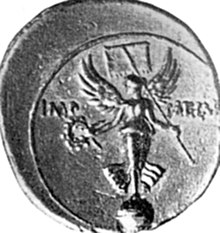Altar of Victory

The Altar of Victory (
History
The statue had been captured by the Romans in 272 BC during the
A modern historian reflects on the importance of the altar and the statue:
- At this Altar of Victory senators burned incense, offered prayers annually for the welfare of the empire, took their oaths and pledged on the accession of each new emperor. Thus the statue became one of the most vital links between the Roman state and Roman religion and also a tangible reminder of Rome's great past and her hopes for the future.[2]
Removal
The altar was removed from the curia by the emperor
After Gratian's death,
Further petitions to restore the altar were deflected in 391 by an edict of the emperor
Writing in 403, Claudian mentioned that the statue (if not the altar) was then in the Senate House.[6] Sheridan states "Some think that removals and restorations refer to both the Altar of Victory and the Statue of Victory. Others think that the Statue was never removed from its place. There is no statement in the ancient authors as to what happened to the Statue when the Altar was removed and certainty on this point is unattainable."[7]
Sheridan further suggests that "the fate of the Altar and Statue of Victory was finally sealed by the law of 408 against heathen statues," citing Codex Theodosianus XVI,10, 19.[8]
Notes
- ^ Prudentius, Contra Symmachum 2.
- ^ Rev. James J. Sheridan, "The Altar of Victory—Paganism's Last Battle" (hereafter Sheridan), p 187.
- ^ Symmachus, Relation III
- ^ Ambrose, Epistles XVII and XVIII
- ^ Ambrose Epistles 57.2
- ^ Claud. VI Cons. Hon. 636.
- ^ Sheridan, p. 206.
- ^ Sheridan, p. 206.
Bibliography
- Sheridan, James J. (1966). "The Altar of Victory - Paganism's Last Battle". L'Antiquité Classique. 35 (1): 186–206. .
- Richard Klein: Symmachus. Eine tragische Gestalt des ausgehenden Heidentums. Darmstadt (Wissenschaftliche Buchgesellschaft [Impulse der Forschung, Band 2]) 1971, ISBN 3-534-04928-4.
- Richard Klein: Der Streit um den Victoriaaltar. Die dritte Relatio des Symmachus und die Briefe 17, 18 und 57 des Mailänder Bischofs Ambrosius. Darmstadt (WBG [Texte zur Forschung Band 7]) 1972, ISBN 3-534-05169-6.
